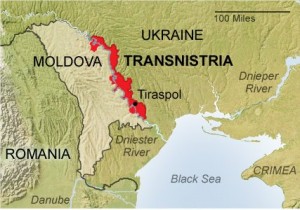
How Russia supports the self-proclaimed Pridnestrovian Moldovan Republic which is not recognized by the global community
More than 20 years ago, shortly after the collapse of the Soviet Union in 1991, local separatists wrested from Moldovan control an industrialized strip of land between the Dnestr River and Ukraine, called the Pridnestrovian Moldovan Republic or Transnistria. Since that time it has been kept afloat by economic and political support from Russia. Transnistria is usually referred to as the breakaway region that doesn’t officially exist because the global community does not recognize its self-declared statehood. Not even Russia recognizes the self-proclaimed republic as independent but it still continues to support Transnistria.
How Russia supports the self-proclaimed Pridnestrovian Moldovan Republic which is not recognized by the global community
More than 20 years ago, shortly after the collapse of the Soviet Union in 1991, local separatists wrested from Moldovan control an industrialized strip of land between the Dnestr River and Ukraine, called the Pridnestrovian Moldovan Republic or Transnistria. Since that time it has been kept afloat by economic and political support from Russia. Transnistria is usually referred to as the breakaway region that doesn’t officially exist because the global community does not recognize its self-declared statehood. Not even Russia recognizes the self-proclaimed republic as independent but it still continues to support Transnistria.
Russian President Vladimir Putin wants all former Soviet states, including Moldova, to join the Customs Union, his brainchild. The Customs Union is still under development and currently has only Russia, Belarus and Kazakhstan as its members. One of its aims is to set up a free trade system. But Moldova’s government does not want to join the Customs Union; instead, it seeks to integrate the country into the European Union. However, by seeking closer ties with EU Moldova is risking disintegration because of the breakaway region of Transnistria. Since Moscow subsidizes the inefficient Transnistrian economy, it is able to control this breakaway republic and its decisions.
There are four sources of income in the Transnistrian economy: exports, cash remittances from expatriate workers, Russian humanitarian aid, and gas subsidies.
Exports are the main source of income for the region’s economy.Several large industrial plants, built in the Soviet era, generate more than half of republic’s yearly GDP. Their production of steel, textile, cement, and electric energy is almost exclusively for export. These plants therefore heavily depend on export activities and the external situation. The Transnistrian economy would collapse if exports were lost or dramatically reduced or if foreign trade became impossible (for example, if a customs border were introduced between Transnistria and Moldova) and no additional external aid was received.
The second major source of income for the Transnistrian economy is cash remittances from expatriate workers, between 66% and 86% of which are sent by residents of Transnistria working in Russia.
Financial assistance from Russia is a key element which makes it possible for the Transnistrian economy to function. This operates both indirectly through so-called gas subsidies and directly via humanitarian aid.
Gas subsidies are  income earned by Tiraspol, the capital of Transnistria, on the domestic sale of Russian gas supplied to the Transnistrian company TiraspolTransGaz-Pridnestrovye by the Moldovan operator MoldovaGaz. Transnistria consumes over two-thirds of the gas supplied by Gazprom to Moldova, but it has not paid anything to the Moldovan company since 2009 and keeps 100% of the profits for itself. MoldovaGaz tolerates Transnistria’s growing debt because Russian company Gazprom holds its controlling stake. The debt is convenient for Russia because it puts political pressure on Moldova. Since Moscow has not officially recognized Transnistria, it can burden Moldova with Transnistria’s debts. The estimated present value of Transnistria’s debt to Gazprom is approximately US$3.7 billion.
income earned by Tiraspol, the capital of Transnistria, on the domestic sale of Russian gas supplied to the Transnistrian company TiraspolTransGaz-Pridnestrovye by the Moldovan operator MoldovaGaz. Transnistria consumes over two-thirds of the gas supplied by Gazprom to Moldova, but it has not paid anything to the Moldovan company since 2009 and keeps 100% of the profits for itself. MoldovaGaz tolerates Transnistria’s growing debt because Russian company Gazprom holds its controlling stake. The debt is convenient for Russia because it puts political pressure on Moldova. Since Moscow has not officially recognized Transnistria, it can burden Moldova with Transnistria’s debts. The estimated present value of Transnistria’s debt to Gazprom is approximately US$3.7 billion.
Moscow has consistently backed the region financially with humanitarian aid. This aid is spent on increasing pensions and financing food supplies for those most in need. In addition to fixed transfers, Russia also offers Transnistria certain ad hoc subsidies for supporting and developing small businesses and for stabilization of the Transnistrian currency. Russia probably also subsidizes Transnistria’s law enforcement agencies, especially the army and the KGB. However, the scale of such aid is undisclosed and thus difficult to assess.
The region’s dependence on financial support from Russia allows the latter to exert political pressure on the government of Transnistria when making decisions. A recent result of Russian political pressure was the republic’s refusal to support Moldova’s integration with the EU. Russia makes it clear that the impoverished post-Soviet country should strengthen its relations with Russia, not with the EU.





